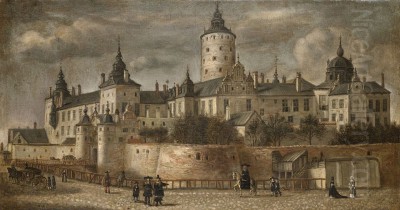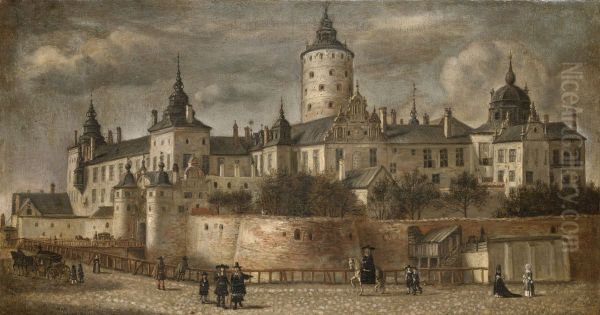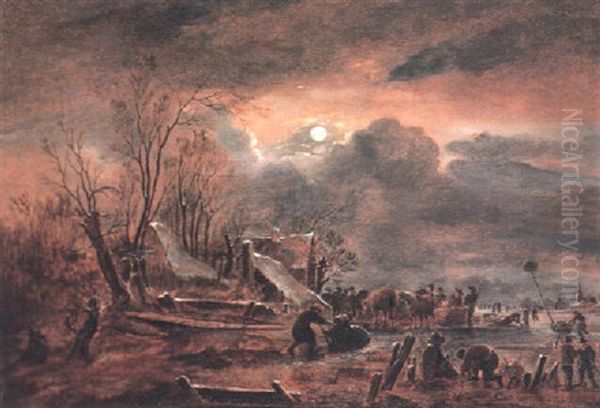
The Dutch Golden Age, spanning roughly the 17th century, was a period of extraordinary artistic efflorescence in the Netherlands. Amidst a burgeoning economy and a society that highly valued art, painters flourished, specializing in genres that captured the nation's landscapes, daily life, and aspirations. Among these talented individuals was Govert Dircksz Camphuysen, a painter whose life and work offer a fascinating glimpse into this vibrant era. Though perhaps not as universally recognized as contemporaries like Rembrandt or Vermeer, Camphuysen carved a niche for himself with his evocative landscapes, detailed animal portrayals, and skillful still lifes, leaving behind a body of work that continues to be appreciated for its sensitivity and technical prowess.
Early Life and Artistic Beginnings in Gorinchem
Govert Dircksz Camphuysen was born in 1624 in Gorcum (also known as Gorinchem), a town in the province of South Holland, though some sources later place it within Groningen's sphere. The accuracy of his birth year is generally accepted by art historians, corroborated by various records. His father was Dirck Rafelsz Camphuysen, a figure of some note, and his mother was Anna van Allendorp. The Camphuysen family was one with artistic inclinations; Govert was not the only painter in the family. His elder brother, Rafael Govertsz Camphuysen (c. 1597/8–1657), was a landscape painter, and another brother, Jochem Govertsz Camphuysen (1601/2–1659), also pursued an artistic career, though his output is less clearly defined and sometimes confused with that of other family members.
Growing up in such an environment likely provided Govert with early exposure to artistic practices. While specific details of his formal training are scarce, it is highly probable that he received initial instruction from his elder brother Rafael, whose style, particularly in landscape painting, may have served as an early influence. Gorinchem, his birthplace, though not as large an artistic center as Amsterdam or Haarlem, was part of a region with a rich artistic tradition, particularly in landscape and genre painting, with nearby Dordrecht being home to prominent artists.
Artistic Development and Specializations

Govert Camphuysen developed into a versatile painter, adept in several genres. He became particularly renowned for his depictions of animals, especially cattle, often set within rustic farmyard scenes or tranquil landscapes. These were not mere anatomical studies but imbued with a sense of life and character, reflecting the importance of agriculture and livestock in the Dutch economy and identity. His animal paintings often feature a soft, atmospheric light, highlighting the textures of fur and hide, and the peaceful demeanor of the creatures.
Beyond animal painting, Camphuysen excelled in landscapes, capturing the flat, water-rich Dutch countryside with its characteristic windmills, cottages, and expansive skies. His landscapes often possess a serene, sometimes melancholic, quality, achieved through subtle gradations of color and a keen observation of light and atmosphere. These works align with the broader trends in Dutch landscape painting, which saw artists like Jan van Goyen and Salomon van Ruysdael pioneer naturalistic and atmospheric depictions of their homeland.
Still life painting was another area where Camphuysen demonstrated his skill. Though perhaps less numerous than his landscapes or animal scenes, his still lifes, such as the noted Still life with oysters, showcase his ability to render textures – the glistening sheen of oysters, the reflective surfaces of metalware, the softness of cloth – with remarkable fidelity. These compositions often carry symbolic meanings, common in Dutch still life, reflecting on themes of transience, wealth, or simple pleasures. He was also recorded as a portrait painter in Amsterdam in 1643, indicating an early foray into this prestigious genre, though fewer portraits by his hand are widely known today compared to his other specializations.
Marriage and Family Life
In 1647, Govert Camphuysen married Petronella Francken. Their union was blessed with three children: Elisabeth, born in 1649; Raphael, born in 1650, likely named in honor of Govert's artist brother; and Goedofridus, born in 1658. Family life was a central aspect of Dutch society, and for an artist, a stable household could provide the necessary support for a demanding career. The births of his children span a period of significant activity in his artistic life, including his eventual move abroad.
The Swedish Sojourn: Court Painter to Royalty
A significant chapter in Camphuysen's life began around 1653 when he relocated to Sweden. The reasons for this move are often attributed to religious persecution in the Netherlands, a plausible motive given that his father, Dirck Rafelsz Camphuysen, was a Remonstrant theologian and poet who faced difficulties due to his religious convictions. The Netherlands, while generally tolerant, did experience periods of religious strife, and artists and intellectuals sometimes sought patronage or refuge elsewhere.

In Sweden, Camphuysen's talents were recognized at the highest level. He became a court painter to King Charles X Gustav and was also closely associated with Queen Hedvig Eleonora. This royal patronage was a mark of considerable prestige and provided him with opportunities to create significant works. He resided and worked in Sweden for approximately a decade, a period that undoubtedly influenced his artistic output and perspective. His role as a court painter would have involved various commissions, potentially including portraits of the royal family and nobility, as well as decorative works for royal residences.
Representative Works: Capturing Castles and Countryside
One of Govert Camphuysen's most famous works from his Swedish period is the painting of the Tre Kronor Castle (Slottet Tre Kronor) in Stockholm. This iconic royal castle, which tragically burned down in 1697, was a potent symbol of Swedish power. Camphuysen's depiction of it, likely commissioned by the royal court, would have been a valuable historical record as well as an artistic achievement. Such paintings not only showcased the artist's skill in architectural rendering and landscape but also served to glorify the monarchy and its seat of power. The painting is often cited as a key work and is held in high esteem, with versions or studies associated with it residing in Swedish collections like the Stockholm City Museum.
Other representative works further illustrate his thematic range. Farm near a Village and Interior of a Cottage (or Interior of a Cowshed) are exemplary of his skill in depicting rural life and animal subjects. These paintings are characterized by their intimate and realistic portrayal of everyday scenes, often imbued with a warm, gentle light. The attention to detail in the rendering of the animals, the textures of wood and straw, and the interplay of light and shadow are hallmarks of his style. These works resonate with the Dutch appreciation for genre scenes, which found parallels in the work of artists like Adriaen van Ostade, known for his peasant interiors, or Paulus Potter, celebrated for his lifelike paintings of cattle.
His Still life with oysters demonstrates his mastery in this genre, aligning him with the tradition of Dutch "pronkstilleven" (ostentatious still lifes) or more modest "ontbijtjes" (breakfast pieces) by artists such as Willem Claesz. Heda or Pieter Claesz., though Camphuysen's approach might have been more subdued. The careful arrangement of objects and the play of light on different surfaces reveal a meticulous technique and an eye for composition.
Artistic Style: Light, Detail, and Atmosphere

Camphuysen's artistic style is firmly rooted in the Dutch realist tradition of the 17th century. A defining characteristic is his sensitive handling of light. Whether it's the soft, diffused light of a cloudy Dutch sky, the warm glow illuminating a barn interior, or the subtle highlights on a still life object, light plays a crucial role in creating mood and defining form in his paintings. This preoccupation with light was shared by many Dutch masters, from the dramatic chiaroscuro of Rembrandt to the luminous interiors of Vermeer, and the atmospheric landscapes of Jacob van Ruisdael.
His attention to detail is another notable feature. Animals are rendered with an understanding of their anatomy and behavior, landscapes include carefully observed foliage and architectural elements, and still lifes present objects with tactile realism. This precision, however, rarely leads to a cold or photographic quality; instead, it contributes to the overall sense of naturalism and authenticity that Dutch patrons so admired.
The atmosphere in Camphuysen's paintings is often one of tranquility and quietude. His rural scenes evoke a sense of peace and harmony with nature, a common theme in Dutch art that offered an escape from the bustling city life. Even in his animal paintings, there is a sense of calm, a depiction of creatures at rest or engaged in simple, natural activities. This contrasts with the more dramatic or heroic subjects favored in other European artistic traditions of the time.
Connections and Contemporaries in the Dutch Art World
Govert Camphuysen operated within a rich and competitive artistic environment. His primary artistic connections were undoubtedly his brothers, Rafael Govertsz Camphuysen and Jochem Govertsz Camphuysen. Rafael, in particular, as an established landscape painter, likely provided both early training and ongoing artistic dialogue.
While direct, documented interactions with many other leading painters are not extensively recorded, Camphuysen's work shows stylistic affinities with several contemporaries. His atmospheric landscapes and use of light can be compared to those of Salomon van Ruysdael and Jan van Goyen, who were pioneers in naturalistic Dutch landscape painting. His detailed animal paintings, especially of cows, inevitably bring to mind the work of Paulus Potter, who was renowned for his monumental depictions of livestock, and Albert Cuyp of Dordrecht, famous for his cattle in sun-drenched landscapes. Cuyp, working in a region close to Camphuysen's birthplace, shared an interest in the effects of light on pastoral scenes.
His genre scenes, particularly interiors with figures and animals, share common ground with artists like Adriaen van Ostade and Adriaen Brouwer, who specialized in peasant life, though Camphuysen's approach was generally less boisterous and more serene than Brouwer's. The meticulous detail in his still lifes echoes the broader tradition of Dutch still life painters, from the opulent compositions of Jan Davidsz. de Heem to the more restrained works of Willem Kalf.
There has been art historical discussion regarding a possible connection with Aert van der Neer, a painter celebrated for his moonlit landscapes and winter scenes. Some scholars suggest that Rafael Camphuysen may have influenced Van der Neer, or that they may have had some association in Amsterdam. Given Govert's familial and artistic ties to Rafael, and his own presence in Amsterdam at times, it's conceivable he was aware of Van der Neer's work, or vice-versa, though concrete evidence of direct tutelage or collaboration is lacking. The Dutch art world was relatively close-knit, with artists often belonging to the same guilds, living in the same cities, and influencing one another through shared exhibitions or apprenticeships. Other notable landscape painters of the era whose work formed the backdrop to Camphuysen's career include Meindert Hobbema and the great Jacob van Ruisdael, whose dramatic and evocative landscapes set a high bar.
Later Years and Return to Amsterdam
After his productive decade in Sweden, Govert Camphuysen eventually returned to the Netherlands. He is documented as being back in Amsterdam by the early 1660s. Amsterdam was the bustling heart of the Dutch Republic and its art market, offering numerous opportunities for established painters. He continued to paint, presumably drawing on his experiences and reputation gained abroad.
His later life is less extensively documented than his Swedish period. He passed away in Amsterdam in 1672. This year marks a turning point in Dutch history, known as the "Rampjaar" (Disaster Year), when the country was invaded by France, England, and other powers, leading to economic decline and a shift in the art market. Camphuysen's death occurred just as this tumultuous period began.
Art Historical Position and Posthumous Evaluation
In the grand narrative of Dutch Golden Age art, Govert Dircksz Camphuysen is considered a skilled and respected, if not leading, figure. He excelled in specific niches, particularly animal painting and atmospheric landscapes with rustic elements. His works are found in various European museums, including the Nationalmuseum in Stockholm and the Statens Museum for Kunst in Copenhagen, testifying to his international reach, partly due to his Swedish connection.
His posthumous reputation has sometimes been complicated by issues of attribution. The fact that several members of the Camphuysen family were painters, and that their styles could sometimes overlap, has occasionally led to confusion. Furthermore, his work has at times been misattributed to other, more famous artists, or conversely, works by lesser hands may have been incorrectly assigned to him. This is not uncommon for artists of his era who did not consistently sign or date their works, or whose signatures were later effaced or altered.
Despite these challenges, art historians recognize Camphuysen's genuine talent and his contribution to the Dutch tradition. His ability to capture the quiet beauty of the Dutch countryside and the gentle nature of its animal inhabitants resonates with a key aspect of Dutch cultural identity. His paintings of cows, for instance, are more than just animal portraits; they reflect the prosperity derived from dairy farming and the Dutch people's deep connection to their land.
His influence on subsequent artists is not extensively traced, but his participation in the popular genres of landscape and animal painting contributed to the overall richness and diversity of Dutch art. Artists like Roelant Savery, though slightly earlier and known for a different, more fantastical style of animal and landscape painting (often featuring exotic animals in lush settings), represents the broader interest in nature and animal depiction that Camphuysen later engaged with in a more typically Dutch, naturalistic manner. It is more likely that Camphuysen would have been aware of Savery's influential work, rather than the other way around.
Unraveling Anecdotes and Lesser-Known Facets
The historical record sometimes contains intriguing but less substantiated details. One such mention in some sources suggests that Govert Camphuysen, despite being trained as a painter, may have briefly considered or even pursued theological studies and become a pastor, perhaps influenced by his father's strong religious background. However, his extensive and continuous career as a painter, including his significant role as a court painter in Sweden, makes a sustained diversion into ministry seem unlikely, or at least a very temporary phase if it occurred at all. It is more probable that this detail is a confusion with his father or other family members who were indeed clergy and faced religious persecution, which in turn likely influenced Govert's decision to move to Sweden.
His close connection with the Swedish Queen Hedvig Eleonora is a more firmly established aspect of his biography, highlighting his success and acceptance in foreign elite circles. The destruction of his painting of the Tre Kronor Castle in the 1697 fire is a poignant historical footnote, reminding us of the fragility of cultural heritage.
The Camphuysen family's complex background, with its experiences of religious dissent and displacement, adds another layer to Govert's story. His father, Dirck Rafelsz Camphuysen, was a notable figure in his own right – a Remonstrant preacher, poet, and scholar who endured exile. This familial context of intellectual and religious engagement, and the resilience shown in the face of adversity, likely shaped Govert's worldview and perhaps his career choices, including the move to Sweden. The family's eventual settlement and success, for instance in Utrecht for some members, speaks to their perseverance.
Conclusion: An Enduring Legacy of Quiet Beauty
Govert Dircksz Camphuysen stands as a noteworthy artist of the Dutch Golden Age, a period unparalleled in its artistic output. His life journey, from his beginnings in Gorinchem, through a significant period of royal patronage in Sweden, to his final years in Amsterdam, reflects the mobility and opportunities available to talented individuals of his time.
His paintings, characterized by their sensitive rendering of light, meticulous detail, and tranquil atmosphere, offer a window into the 17th-century Dutch and Swedish worlds. Whether depicting peaceful pastoral scenes, intimate farmyard interiors, or carefully composed still lifes, Camphuysen's work embodies the Dutch appreciation for the beauty of the everyday and the natural world. While he may not have achieved the towering fame of some of his contemporaries, his artistic contributions are significant, and his paintings continue to be admired for their quiet charm and technical skill, securing his place as a respected master of the Dutch Golden Age. His legacy is a testament to an artist who skillfully captured the essence of his time, leaving behind images that still evoke a sense of peace and an appreciation for the enduring beauty of the world around us.